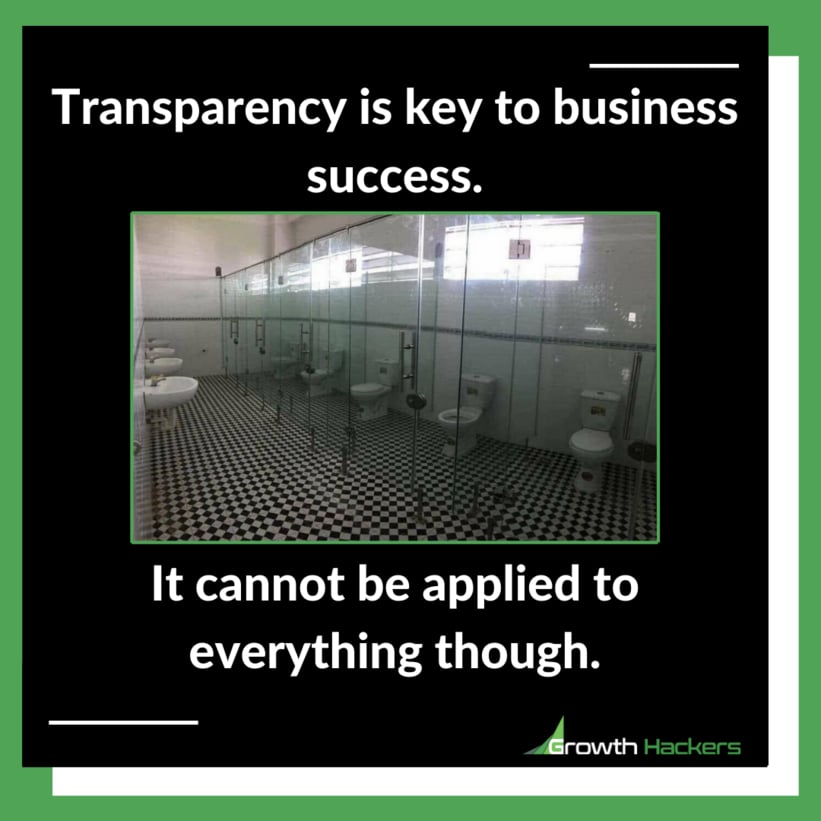Hello!
Steve Morrison, a retail chain owner in Canada, became successful after almost five years of consistent efforts. He rose from a humble beginning and built a prosperous business. Most of the credit to the success of brand goes to brand transparency across the business operations.
Transparency is indeed the buzzword that will help you win over your consumers. As globalisation touched every aspect of the business, the business owners began arming to the consumer-centric approach instead of the aggressive profit-driven methods. That’s when it became necessary to maintain transparency to establish the credibility of businesses.
Even though it may seem like a rather simple process to implement, maintaining transparent operations doesn’t necessarily come naturally. This is particularly true in the case of larger organisations where there are more people, layers, and complexities involved in the business. So, let’s quickly dive into the process of brand transparency, why it’s important and how it can be adopted.
A Few Amazing Reasons Why Transparency Is Important
Promotes growth
 When the loyalty and trust of the consumer are strong, the growth and success of your business will follow automatically. Consumers are more likely to repeat their purchases, and to leave a positive review or refer a friend, when businesses earn their trust.
When the loyalty and trust of the consumer are strong, the growth and success of your business will follow automatically. Consumers are more likely to repeat their purchases, and to leave a positive review or refer a friend, when businesses earn their trust.
This way, the brand perception is enhanced, which further develops the goodwill of the brand and increases engagement.
However, there’s another pertinent way that brand transparency promotes business growth. This happens when businesses allow employees and other partners reasons to feel committed, engaged, and accountable to the business and its objectives.
Brand trust is everything
Building trust is vital more than ever now as a study from Business2community reveals that only 34% of consumers say they trust most of the brands they use. On the other hand, once trust is gained, 62% of consumers stay loyal. So, it’s evident that brand transparency develops trust. This is also applicable case employees, partners, and suppliers that work closely with the business.
Having solid and simple dispute resolution or return policies, for instance, allow consumers the confidence to buy from brands without second thoughts. Amazon has managed to gain a massive foothold in the apparel industry owing to their no-hassle return policy that’s communicated simply.
Brings in the element of authenticity
 Honesty and authenticity go a long way to attract a steady stream of customers. However, a business can’t be authentic without maintaining proper transparency. An organisation that is transparent has laid down its own values, ground rules, processes, and policies, and proved that it has nothing to hide.
Honesty and authenticity go a long way to attract a steady stream of customers. However, a business can’t be authentic without maintaining proper transparency. An organisation that is transparent has laid down its own values, ground rules, processes, and policies, and proved that it has nothing to hide.
But it’s not just about preaching the lofty ideals, a brand has to also steadfastly follow through on its values and promises to really consolidate its authenticity.
Employee engagement
Employees who have a true stake in the brand will be more willing to innovate, think and act outside of the box, and devote more of their time and talent.
 Brand transparency can promote employee engagement by incorporating them into decision-making processes. The process also involves conveying changes are the reasons for those changes and offering transparent performance reviews that genuinely help with personal and professional development.
Brand transparency can promote employee engagement by incorporating them into decision-making processes. The process also involves conveying changes are the reasons for those changes and offering transparent performance reviews that genuinely help with personal and professional development.
“A brilliant way to engage with the employees is by holding face-to-face meetings”, state Gary Osment, an essay writer for Allessaywriter.com. Non-verbal communication generally has a great impact, and personal connections are nurtured easily. Another way is cross-department mentoring, which allows employees exposure to other departments and processes of the company.
Helps keep your competitors in check
Consumers today have a dozen options for one single product. They are often chased by different companies luring them with their lavish ads and tempting offers. So, it may seem really difficult to stand out from all these brands and find a position in the market. But you can still hit it out of the park as long as you use brand transparency as your trump card.
Think about it; would clients order a product to a company that offers vague and scant information? Or, would they put their money to an item which presents a crystal-clear image? This is the reason why the brand transparency will strengthen your brand’s credibility to the extent that no other similar service provider will be able to match it.
Brings in the element of authenticity
Honesty and authenticity go a long way to attract a steady stream of customers. However, a business can’t be authentic without maintaining proper transparency. An organisation that is transparent has laid down its own values, ground rules, processes, and policies, and proved that it has nothing to hide.
But it’s not just about preaching the lofty ideals, a brand has to also steadfastly follow through on its values and promises to really consolidate its authenticity.
Employee engagement
Employees who have a true stake in the brand will be more willing to innovate, think and act outside of the box, and devote more of their time and talent.
Brand transparency can promote employee engagement by incorporating them into decision-making processes. The process also involves conveying changes are the reasons for those changes and offering transparent performance reviews that genuinely help with personal and professional development.
“A brilliant way to engage with the employees is by holding face-to-face meetings”, state Gary Osment, an essay writer for Allessaywriter.com. Non-verbal communication generally has a great impact, and personal connections are nurtured easily. Another way is cross-department mentoring, which allows employees exposure to other departments and processes of the company.
Helps keep your competitors in check
Consumers today have a dozen options for one single product. They are often chased by different companies luring them with their lavish ads and tempting offers. So, it may seem really difficult to stand out from all these brands and find a position in the market. But you can still hit it out of the park as long as you use brand transparency as your trump card.
Think about it; would clients order a product to a company that offers vague and scant information? Or, would they put their money to an item which presents a crystal-clear image? This is the reason why the brand transparency will strengthen your brand’s credibility to the extent that no other similar service provider will be able to match it.
Efficient Ways To Maintain Brand Transparency
Communicate with all honesty
 Whether it’s through a blog post, internal memo, or product description, transparency is created when the process of communication is honest and straightforward.
Whether it’s through a blog post, internal memo, or product description, transparency is created when the process of communication is honest and straightforward.
For instance, never use stock images of enthusiastic workers on the team page of the website, include real employees, instead. Make sure to mention accurate product details, which may include sourcing, sizing, materials, and more.
Keep the prices straightforward and open
Sometimes, businesses tend to hold back details on their pricing structure for fear that it will drive away potential customers. But this is counterintuitive. Many studies indicate that consumers tend to invest more than they would if they hadn’t been exposed to pricing.
When a product or item is priced attractively, it makes sense to maintain transparency. However, even in the case of products or services where the pricing is complex, it’s better to be upfront with the customers. Businesses need to provide clients with accurate and complete pricing information whenever they request it.
Proper pricing details results in more transparency since it opens up a conversation about sourcing, the supply process, and extra taxes that may be included in the price. Pricing isn’t only an opportunity for transparency; it can promote cross-sell and upsell opportunities as well.
Ensure your privacy and data policies are accessible and clear
 Consumers may want to learn how their data is being used as well as shared, and businesses have an obligation to their users to be open about it. As per the Consumer Policy Research Centre, nearly 95% of people want to launch businesses to provide options to opt-out of the information gathered about them, how it is utilised and/or how much is shared with third-parties.
Consumers may want to learn how their data is being used as well as shared, and businesses have an obligation to their users to be open about it. As per the Consumer Policy Research Centre, nearly 95% of people want to launch businesses to provide options to opt-out of the information gathered about them, how it is utilised and/or how much is shared with third-parties.
Make sure you inform potential consumers how you deal with their data by making your policy accessible. In fact, even with marketing emails, it’s crucial to provide your audience with the choices for managing their preferences and opting out of communications in the future. Convey to clients that their privacy and preferences are your priority.
Use social media platforms to talk directly to customers
Social media channels are possibly the most transparent platforms today since it fosters direct communication between brands and their consumers. Moreover, it doesn’t require the intervention of a third party. A staggering 81% of consumers opine that social media has maximised the accountability among businesses.
The best business pages on social media platforms are proactive about interacting with consumers. They also offer relevant, useful information, and responding to feedback and queries, even if it’s negative.
Share behind-the-scenes glimpses
When you make the production, planning, and delivery processes public, you increase the assurance among the consumers. This also helps you create an intimate relationship with your consumers. What may seem like quite ordinary details to you might be intriguing to a consumer hoping for brand transparency.
Customers care about the sources of their purchases, and it’s essential to show where your products come from and how they are handled across the whole supply chain. So, feel free to pull back the curtain to these details with information, photos or even videos.
Promote honest feedback
Most businesses today are already aware that in order to prosper, they need to be honest with their consumers. This means offering platforms for consumers to provide their unfiltered feedback about the products or services.
 Organisations like Amazon have proper processes to decipher whether a review is verified. In fact, the feedback and rating function of social media business pages are transparent so that brands can’t use anonymous reviews to maintain their online reputation.
Organisations like Amazon have proper processes to decipher whether a review is verified. In fact, the feedback and rating function of social media business pages are transparent so that brands can’t use anonymous reviews to maintain their online reputation.
Social media makes it convenient for clients to put their name and face to their statement, which makes the feedback real and authentic. Brands shouldn’t be apprehensive from offering platforms for honest customer feedback. Even bad reviews can present a positive impact if the organisation is transparent about what they are doing to deal with the problem or compensate the customer.
Be More Transparent About Your Brand
Proper transparency in business is not really a one-off activity; it demands a constant effort. It should reflect on the company values and all aspects of the operations and brand identity. It has to be practised consistently and regularly for it to yield a favourable outcome for businesses. Brand transparency places total ownership and accountability in the hands of the company itself. When a brand is transparent about its values, processes, products, and goals, nobody else can dictate to the business who it is or what it should be.
- 6 Technologies To Improve Your Branding
- How to Boost Your Brand Reputation if You Are a Small Business?
- Brand Marketing and Performance Marketing in a Nutshell
- Why Metaverse is Rising: Crypto, NFT, and Big Brands
- 7 Tips for Protecting Your Brand Against Cyberattacks
- 7 Effective Tactics For Humanizing Your Brand (With Examples)
- 5 Ways to Increase Brand Awareness Using NFTs
- How to Successfully Rebrand Your Business
Thank you!
Subscribe to our newsletter! Join us on social networks!
See you!






